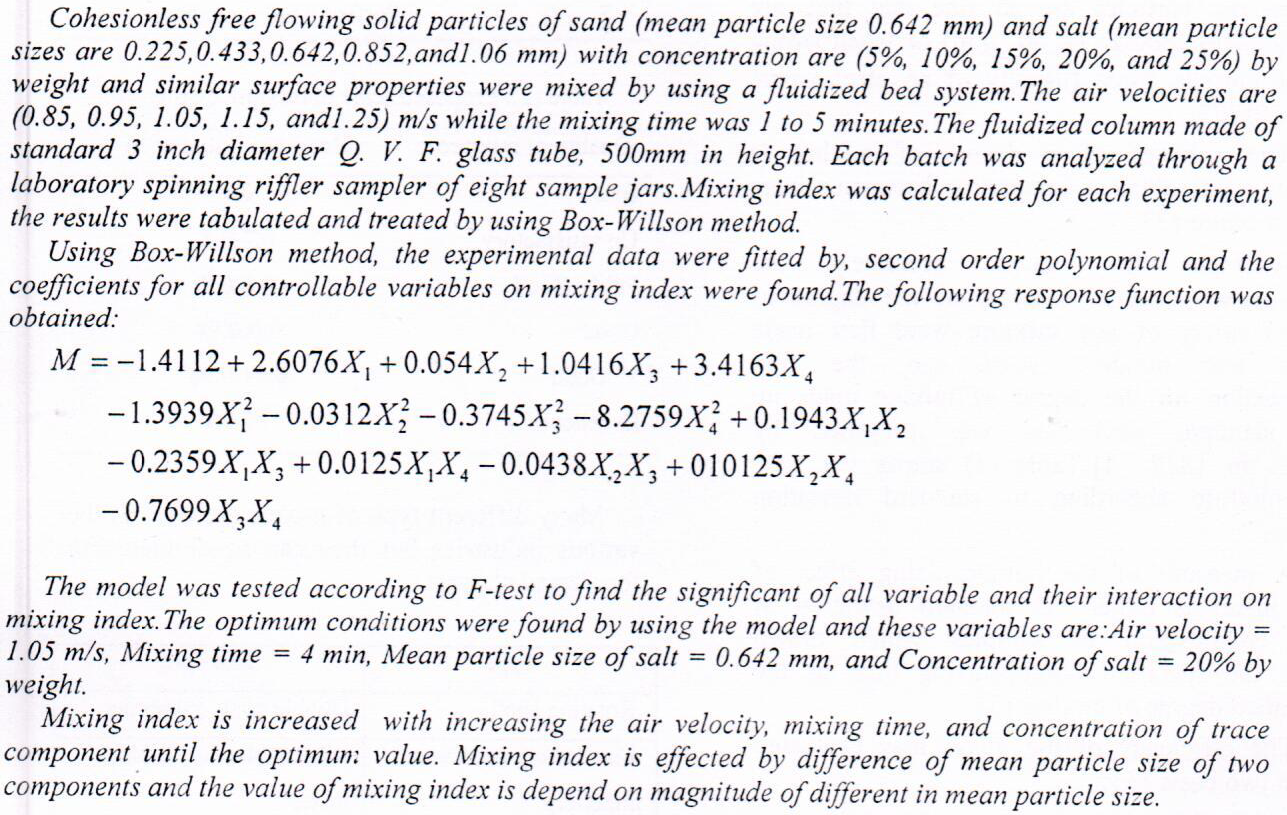
The -mixing of - transition in Er 168 populated in Er)n,n(Er 168168 reaction is calculated in the present work by using a2- ratio method. This method has used in previou studies [4, 5, 6, 7] in case that the second transition is pure or for that transition which can be considered as pure only, but in one work we applied this method for two cases, in the first one for pure transition and in the 2nd one for non pure transitions. We take into accunt the experimental a2- coefficient for p revious works and -values for one transition only [1]. The results obtained are, in general, in agood agreement within associated errors, with those reported previously [1], the discrepancies that occur are due to inaccuracies existing
... Show MorePerformance of gas-solid spouted bed benefit from solids uniformity structure (UI).Therefore, the focus of this work is to maximize UI across the bed based on process variables. Hence, UI is to be considered as the objective of the optimization process .Three selected process variables are affecting the objective function. These decision variables are: gas velocity, particle density and particle diameter. Steady-state solids concentration measurements were carried out in a narrow 3-inch cylindrical spouted bed made of Plexiglas that used 60° conical shape base. Radial concentration of particles (glass and steel beads) at various bed heights and different flow patterns were measured using sophisticated optical probes. Stochastic Genetic
... Show MoreBackground: The bonded orthodontic retainer constructed from multistrand wire and composite is an efficient esthetic retainer, which can be maintained long-term. Clinical failures of bonded orthodontic retainers, most commonly at the wire/composite interface, have been reported. This in vitro investigation aimed to evaluate the tensile forces of selected multistrand wires and composite materials that are available for use in the construction of bonded fixed retainers. Materials and Methods: The study sample includes 120 wires with three types of retainer wires (3 braided strands\ Orthotechnology, 8 braided strands\ G&H Orthodontics, 6 coaxial strands\ Orthoclassic wires), two types of adhesive (flowable\ Orthotechnology, non flowable\ G&H O
... Show MoreMetal complexes of Cu (II), Fe (III) and Mn (II) with Quinaldic acid (L1) and 1, 10-Phenathroline (L2) are synthesized and characterized by standaral physic- chemical procedures (element analysis, metal analysis, FTIR, Uv-Vis, magnetic moment and conductometeric measurements). On the base of these studies, mononuclear and six coordinated octahedral geometry and nonelectrolyte of these complexes have been proposed. The standard heat of formation (?Hºf) and binding energy (?Eb) for the free ligands and their complexes are calculated by using the PM3 method at 273K of Hyperchem.-8 program. The complexes are more stable than their ligands. Moreover, the electrostatic potential of free ligands are measured to investigate the reactive site of th
... Show More (2)
(2)
Two samples of (Ag NPs-zeolite) nanocomposite thin films have been prepared by easy hydrothermal method for 4 hours and 8 hours inside the hydrothermal autoclave at temperatures of 100°C. The two samples were used in a photoelectrochemical cell as a photocatalyst inside a cell consisting of three electrodes: the working electrode photoanode (AgNPs-zeolite), platinum as a cathode electrode, and Ag/AgCl as a reference electrode, to study the performance of AgNPs-zeolite under dark current and 473 nm laser light for water splitting. The results show the high performance of an eight-hour sample with high crystallinity compared with a four-hour sample as a reliable photocatalyst to generate hydrogen for renewable energies.
This study investigates the influence of Strategic Consensus (SC) on Organizational Performance (OP), with Strategic Alignment (SA) serving as a mediating variable, within private academic institutions in Iraq. The research utilized scales developed to measure each variable: SC, OP, and SA, all of which are unidimensional. The sample comprised 131 senior participants, including deans and faculty council members, with questionnaires distributed across three institutions: Dijla University College (35 respondents), Baghdad College of Economic Sciences (31 respondents), and the University of Uruk (65 respondents). Data analysis employed various statistical techniques, including normality testing, confirmatory factor analysis, descriptive statis
... Show More (1)
(1)
Atorvastatin (ATR) is a poorly water-soluble anti-hyperlipidemic drug. The drug belongs to the class II group according to the biopharmaceutical classification system (BCS) with low bioavailability due to its low solubility. Solid dispersion is an effective technique for enhancing the solubility and dissolution of drugs. Phospholipid solid dispersion (PSD) using phosphatidylcholine (PC) as a carrier with or without adsorbent (magnesium aluminum silicate, silicon dioxide 15nm, silicon dioxide 30nm, calcium silicate) was used to prepare ATR PSD using different drug: PC: adsorbent ratios by solvent evaporation method. The resulted PSD was evaluated for its percentage yield, drug content, solubility, dissolution rate, Fourier transforma
... Show More (7)
(7)
 (5)
(5)
Atorvastatin (ATR) is poorly soluble anti-hyperlipidemic drug; it belongs to the class II group according to the biopharmaceutical classification system (BCS) with low bioavailability due to its low solubility. Solid dispersions adsorbate is an effective technique for enhancing the solubility and dissolution of poorly soluble drugs.
The present study aims to enhance the solubility and dissolution rate of ATR using solid dispersion adsorption technique in comparison with ordinary solid dispersion. polyethylene glycol 4000 (PEG 4000), polyethylene glycol 6000 (PEG 6000), Poloxamer188 and Poloxam
... Show More (13)
(13)
 (1)
(1)
Meloxicam (MLX) is non-steroidal anti -inflammatory, poorly water soluble, highly permeable drug and the rate of its oral absorption is often controlled by the dissolution rate in the gastrointestinal tract. Solid dispersion (SD) is an effective technique for enhancing the solubility and dissolution rate of such drug.
The present study aims to enhance the solubility and the dissolution rate of MLX by SD technique by solvent evaporation method using sodium alginate (SA), hyaluronic acid (HA), collagen and xyloglucan (XG) as gastro-protective hydrophilic natural polymers.
Twelve formulas were prepared in different drug: polymer ratios and evaluated for their, percentage yield, drug content, water so
... Show More (12)
(12)
 (5)
(5)
